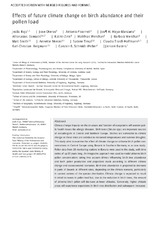Mostrar el registro sencillo del ítem
Effects of future climate change on birch abundance and their pollen load
| dc.contributor.author | Rojo, Jesús | |
| dc.contributor.author | Oteros, José | |
| dc.contributor.author | Picornell, Antonio | |
| dc.contributor.author | Maya-Manzano, José María | |
| dc.contributor.author | Damialis, Athanasios | |
| dc.contributor.author | Zink, Katrin | |
| dc.contributor.author | Werchan, Matthias | |
| dc.contributor.author | Werchan, Barbora | |
| dc.contributor.author | Smith, Matt | |
| dc.contributor.author | Menzel, Annette | |
| dc.contributor.author | Timpf, Sabine | |
| dc.contributor.author | Traidl-Hoffmann, Claudia | |
| dc.contributor.author | Bergmann, Karl C. | |
| dc.contributor.author | Schmidt-Weber, Carsten | |
| dc.contributor.author | Buters, Jeroen | |
| dc.date.accessioned | 2024-02-08T21:03:36Z | |
| dc.date.available | 2024-02-08T21:03:36Z | |
| dc.date.issued | 2021 | |
| dc.identifier.issn | 1354-1013 | |
| dc.identifier.uri | http://hdl.handle.net/10396/27337 | |
| dc.description.abstract | Climate change impacts on the structure and function of ecosystems will worsen public health issues like allergic diseases. Birch trees (Betula spp.) are important sources of aeroallergens in Central and Northern Europe. Birches are vulnerable to climate change as these trees are sensitive to increased temperatures and summer droughts. This study aims to examine the effect of climate change on airborne birch pollen concentrations in Central Europe using Bavaria in Southern Germany as a case study. Pollen data from 28 monitoring stations in Bavaria were used in this study, with time series of up 30 years long. An integrative approach was used to model airborne birch pollen concentrations taking into account drivers influencing birch tree abundance and birch pollen production and projections made according to different climate change and socioeconomic scenarios. Birch tree abundance is projected to decrease in parts of Bavaria at different rates, depending on the climate scenario, particularly in current centres of the species distribution. Climate change is expected to result in initial increases in pollen load but, due to the reduction in birch trees, the amount of airborne birch pollen will decrease at lower altitudes. Conversely, higher altitude areas will experience expansions in birch tree distribution and subsequent increases in airborne birch pollen in the future. Even considering restrictions for migration rates, increases in pollen load are likely in Southwestern areas, where positive trends have already been detected during the last three decades. Integrating models for the distribution and abundance of pollen sources and the drivers that control birch pollen production allowed us to model airborne birch pollen concentrations in the future. The magnitude of changes depends on location and climate change scenario. | es_ES |
| dc.format.mimetype | application/pdf | es_ES |
| dc.language.iso | eng | es_ES |
| dc.publisher | Wiley | es_ES |
| dc.rights | https://creativecommons.org/licenses/by-nc-nd/4.0/ | es_ES |
| dc.source | Rojo, J., Oteros, J., Picornell, A., Maya‐Manzano, J. M., Damialis, A., Zink, K., Werchan, M., Werchan, B., Smith, M., Menzel, A., Timpf, S., Traidl‐Hoffmann, C., Bergmann, K., Schmidt‐Weber, C. B., & Buters, J. (2021). Effects of future climate change on birch abundance and their pollen load. Global Change Biology, 27(22), 5934-5949. https://doi.org/10.1111/gcb.15824 | es_ES |
| dc.subject | Betula | es_ES |
| dc.subject | Climate change | es_ES |
| dc.subject | Ecological modelling | es_ES |
| dc.subject | Plant distribution | es_ES |
| dc.subject | Pollen exposure | es_ES |
| dc.subject | Pollen production | es_ES |
| dc.subject | Temperate trees | es_ES |
| dc.title | Effects of future climate change on birch abundance and their pollen load | es_ES |
| dc.type | info:eu-repo/semantics/article | es_ES |
| dc.relation.publisherversion | https://doi.org/10.1111/gcb.15824 | es_ES |
| dc.rights.accessRights | info:eu-repo/semantics/openAccess | es_ES |

